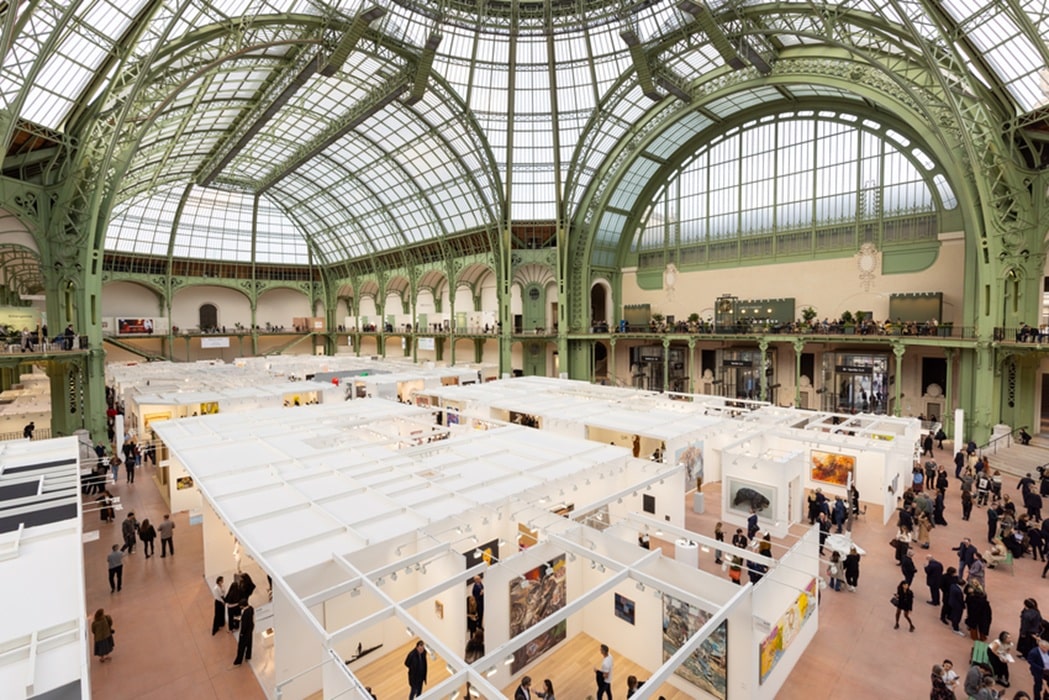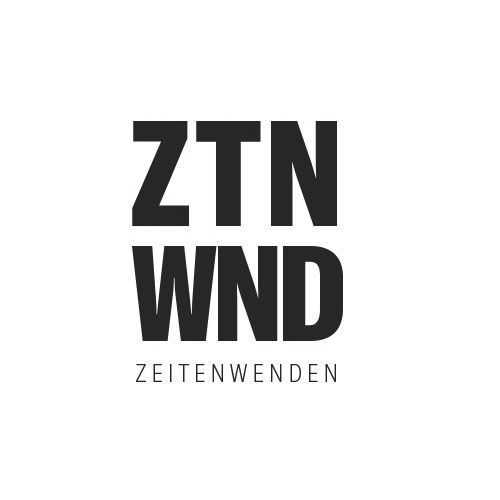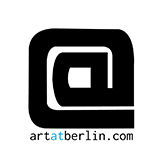Art Basel Paris returns this October to the renovated Grand Palais, placing the city and its avant-garde legacy at the heart of this year’s edition.
Image above: Art Basel Paris, Courtesy of Art Basel.
While last year marked the long-awaited move to the historic venue, the 2025 edition of Art Basel Paris, led by Clément Delépine, deepens the dialogue with the city itself. With 206 leading international galleries participating – including 180 within the Galeries sector – and 65 exhibitors operating spaces in France, the fair highlights the strength and vitality the country’s gallery scene and art ecosystem. Art Basel Paris runs from October 24-26, 2025, with Preview Days on October 22 and 23, 2025. Tickets the show, including to the publicly accessible Vernissage on the evening of October 23, are now exclusively available on artbasel.com/paris/tickets.
For more than a century, Paris has stood as a cradle of creativity – a living history that will be reflected across its sectors and Public Program. Cubism, Surrealism, Situationism, and many other movements were born in the French capital, and generations of artists, writers, and thinkers shaped ideas that reverberated far beyond the city. That avant-garde will be palpable at the show, thanks to a rich blend of established galleries, cutting-edge newcomers, and world-class creatives. During Art Basel Paris, the fair also acts as the primary catalyst of France’s competitive art market – which operates as the fourth largest worldwide, accounting for 7% of global art market sales and more than half of the EU’s total value, according to the Art Basel and UBS Global Art Market Report 2025.
While every Art Basel fair reflects the dynamic interplay between the show and its host city, Art Basel Paris’ connection with the city becomes particularly evident under the glass roof of one of Paris’ most iconic architectural landmarks, host of many defining moments for Modern and contemporary art. This ever-growing connection is further underscored by this year’s Public Program, unfolding across nine iconic venues of the French capital, as well as by Art Basel Paris’ ties to the city’s creative industries, embodied this year by its re-hanging initiative Oh La La!, art-directed by French fashion documentarian and filmmaker Loïc Prigent; its dynamic Conversations Program, with celebrated fashion editor Edward Enninful as guest curator for a day; and the impactful artistic projects of the show’s partners.
Galeries
Art Basel Paris’ main sector, Galeries, reunites 206 exhibitors from 41 countries and territories, presenting the full breadth of their programs. From early 20th-century pioneers and Postwar luminaries to blue-chip masters and ultra-contemporary voices, the presentations reflect the show’s unparalleled scope. This year, the sector sees a wide variety of presentations centered around the broader theme of avant-garde, highlighting Paris’ enduring role as a laboratory of experiment and exchange. Across historic rediscoveries and daring new proposals, the galleries together sketch a lineage that connects Paris’ cultural histories with the global conversations of today.
From early avant-garde to Postwar radicalism
Several galleries from Paris and beyond spotlight artists whose radical experiments defined the first half of the 20th century, when Paris was the undisputed epicenter of the avant-garde.
- Galerie Le Minotaure (Paris) showcases Dimensionism, the avant-garde movement inspired by Einstein’s theories of space-time and articulated in Charles Sirató’s 1936 manifesto. The presentation brings together rare watercolors by Fernand Léger from the late 1910s, as well as László Moholy-Nagy’s photograms, collages, and plexiglass compositions. Shown together in Paris, these works capture the experimental spirit of the interwar period and highlight how Dimensionism anticipated the cross-disciplinary approaches central to contemporary art.
- Galerie 1900–2000 (Paris, New York) shows rare works by major figures of Dada and Surrealism alongside emblematic voices of the interwar avant-garde – artists who never met, yet were all profoundly shaped by their time in Paris. At its center is a study drawing for Marcel Duchamp’s 9 moules malic (1913–14), created during the artist’s formative Paris years, shown in dialogue with Hannah Höch’s Kubistische Komposition I (1923), an early example of her radical approach to form, and an illustrated letter by Victor Brauner from 1934. The booth also features embroidered and textile compositions from the early 1960s by Mimi Parent and a 1970s oil painting by Félix Labisse, underscoring the gallery’s commitment to presenting Surrealism’s enduring legacy.
Other presentations turn to the latter half of the 20th century, a time when Paris continued to be a site of reinvention, bridging traditions of modernism with new artistic languages, but also saw the rise of important movements beyond the French capital.
- Gió Marconi (Milan) presents a curated selection of works that includes Valerio Adami’s 1960s drawings and paintings, shaped by his Paris years and links to Nouvelle Figuration; intimate gouaches by Sonia Delaunay from the 1930s, echoing her pioneering role in abstraction; and sculptural assemblages by Louise Nevelson, whose shadowed reliefs connect to the material explorations of European modernism. Completing the presentation, Emilio Tadini’s Archeologia (1970) reflects the vibrant exchanges between Italian and French artistic circles in the postwar period.
- Tornabuoni Art (Florence, Paris, Milan, Rome, Forte dei Marmi, Crans-Montana) brings together works by Giorgio Morandi and Lucio Fontana, two pioneers of 20th-century language. While their paths never crossed, both sought to move beyond traditional representation: Morandi by distilling still lives and landscapes into meditations on the unseen within the everyday, and Fontana by piercing the canvas to reveal infinite space beyond the visible. Their dialogue is complemented by works by Alighiero Boetti, including a blue ballpoint drawing and one of his iconic Mappa tapestries.
- Vedovi Gallery (Brussels) presents Abstraktes Bild (1992) by Gerhard Richter. A pivotal figure in postwar painting, Richter has consistently challenged the boundaries between abstraction and representation. This work, part of his celebrated series, reflects the artist’s exploration of gesture, chance, and perception, extending the avant-garde legacy of abstraction into the late 20th century.
- Van de Weghe (New York) spotlights Jean-Michel Basquiat’s Untitled (1983), a striking silkscreen on canvas from a series of ten works created that year. The piece exemplifies Basquiat’s raw energy and distinctive visual language, merging bold imagery with layered meaning at a pivotal moment in his career. Complementing this highlight are works by Pablo Picasso and Andy Warhol, which situate Basquiat’s practice in dialogue with other masters of the 20th century.
Building on this legacy, other galleries foreground today’s most daring practices, reaffirming Paris’ role as a stage for the contemporary avant-garde.
- Galerie Max Hetzler (Berlin, Paris, London, Marfa) will present works by Albert Oehlen, Bridget Riley, Katharina Grosse, and Sabine Moritz. A leading voice in contemporary avant-garde, Oehlen’s paintings – oscillating between figuration and abstraction – will coincide with his exhibition Endless Summer at Gagosian and Max Hetzler in Paris. Riley’s hypnotic compositions, rooted in her engagement with Georges Seurat, are the subject of a major exhibition at the Musée d’Orsay opening the same week. For the first time at Art Basel Paris, the gallery will also show works by Sabine Moritz, whose practice intertwines memory, history, and lived experience in a lyrical painterly language.
- Xavier Hufkens (Brussels) will present a cross-generational grouping that brings together Louise Bourgeois, Tracey Emin, Charline von Heyl, Mark Manders, and Cecilia Vicuña. Bourgeois, a central figure of Postwar art, is represented with a late bronze from 2005, while Emin’s new painting Hunter (2025) and von Heyl’s Menelaos (2024) highlight contemporary developments in figuration and abstraction, echoing these two currents’ strong ties to the French capital. Manders contributes a monumental sculptural assemblage realized between 2015 and 2025, and Vicuña’s Corazones (2024) adds a poetic and painterly dimension. Seen together, the presentation underscores the gallery’s commitment to artists whose work continues to shape the evolving language of the avant-garde.
- Sfeir-Semler Gallery (Hamburg, Beirut) will present a selection including Etel Adnan, Samia Halaby, Marwan, Dana Awartani, Lawrence Abu Hamdan, Tarik Kiswanson, and others. At its center is a luminous 1990s canvas by Adnan, the Lebanese-born, Paris-based poet and painter whose vibrant abstractions have become emblematic of the city’s postwar avant-garde legacy. Shown in dialogue with works ranging from Halaby’s expansive abstractions and Marwan’s expressive heads to Awartani’s textile-based meditations and Abu Hamdan’s conceptual investigations, the presentation highlights how questions of identity, memory, and political engagement continue to shape avant-garde trajectories across the Arab world and its diaspora.
Finally, influential Parisian galleries naturally anchor the sector, reaffirming the city’s living connection to avant-garde heritage.
- Galerie Nathalie Obadia (Paris, Brussels) will spotlight two artists deeply connected to the legacy of the French avant-garde: Shirley Jaffe and Roger-Edgar Gillet. American-born Jaffe spent most of her life in Paris, transforming Postwar abstraction with her luminous, geometric compositions, while Paris-born Gillet bridged Tachisme and expressionist figuration in textured, gestural surfaces.
- Loevenbruck (Paris) highlights a dialogue between landmark retrospectives and new contemporary voices. Anchoring the presentation is Głowa VI (1961) by Alina Szapocznikow, whose radical explorations of the fragmented body remain a touchstone in postwar European art. Works by Gilles Aillaud, Daniel Dewar & Grégory Gicquel, Ashley Hans Scheirl, and Chloé Royer bring a contemporary dimension, underscoring the gallery’s commitment to artists who expand sculptural and pictorial languages today.
- galerie frank elbaz (Paris) brings together Sheila Hicks, Chloé Delarue, Machiko Ogawa, and Kenjiro Okazaki. Living in Paris since the 1960s, Hicks continues her groundbreaking exploration of fiber as sculptural and architectural language. Delarue’s hybrid assemblages, Ogawa’s porcelain forms, and Okazaki’s poetic canvases expand the reflection into themes of transformation, fragility, and cultural exchange.
- Galerie Christophe Gaillard (Paris) spotlights Simon Hantaï’s monumental Tabula (1975), a landmark of his celebrated pliage technique, made in postwar Paris. Anchoring the booth, it is joined by Hélène Delprat’s glitter-laden Autoportrait catastrophique (2024) and Eric Baudart’s OTS 12 (2021), together reflecting Paris’ enduring spirit of experimentation.
- Galerie Jousse Entreprise (Paris) will present Humeur aqueuse, a group exhibition bringing together Nathan Bertet, Anne-Charlotte Finel, Nathanaëlle Herbelin, Ange Leccia, and Simon Martin. Anchored in notions of perception and affect, the presentation explores the formation of images and the emotional states they transmit. Leccia, a key figure of the French avant-garde since the 1980s, is shown alongside younger voices who extend this experimental lineage across painting, video, and installation.
Among the international cohort of 29 galleries that are participating in Art Basel Paris for the first time, the main sector welcomes 13 newcomers. Together, these first-time participants resonate with Paris’ multicultural heritage while opening new perspectives for today. Their presentations range from revisited histories and postcolonial narratives to bold experiments in form and material, embodying the spirit of invention that has defined Paris for over a century.
- Crèvecœur (Paris) brings together Miho Dohi, Inès di Folco Jemni, Ernst Yohji Jaeger, Yu Nishimura, Louise Sartor, Naoki Sutter-Shudo, and rare works by Morikazu Kumagai. Anchored in the Japanese concept of mono no aware – the experience of impermanence – the presentation opens fresh possibilities for breaking with European pictorial and sculptural conventions. Another highlight of the gallery’s presentation will be works by French Colombian painter Emma Reyes, whose career primarily unfolded in Paris, where she developed her bold, vibrant pictorial language.
- The Approach (London) stages a group presentation with Anderson Borba, Jai Chuhan, Sara Cwynar, Sandra Mujinga, Paloma Proudfoot, and Mike Silva. Spanning painting, sculpture, photography, film, and installation, the works revisit themes central to the avant-garde – the body, identity, memory, and social critique – and reimagine them for the present.
- Lodovico Corsini (Brussels) features new kinetic sculptures by Meriem Bennani, extending her acclaimed Cursed Objects series, alongside paintings by Calvin Marcus and pastels by Peter Wächtler. The presentation explores transformation, perception, and the human condition, echoing the experimental drive that unites the artists on the gallery’s roster.
- 1 Mira Madrid / 2 Mira Archiv (Madrid) presents the complete archive of Lea Lublin (1929–1999), a key figure of European conceptualism whose work engaged feminism, semiotics, and social critique. Complementing this, the booth includes recent works by Esther Ferrer, a pioneer of performance and conceptual art. Both artists arrived in Paris in the late 1960s, shaping practices grounded in feminist discourse and political engagement.
- David Nolan Gallery (New York) spotlights works on paper, a medium at the heart of the gallery’s program. Museum-quality drawings by Hans Bellmer, Christina Ramberg, Martin Kippenberger, Dorothea Rockburne, and Nicole Eisenman reflect diverse avant-garde approaches to the body, space, and society across generations.
- Stevenson (Cape Town, Johannesburg, Amsterdam) debuts with Seismic shifts: South Africa in the ’90s, revisiting how artists including Jane Alexander, Steven Cohen, Moshekwa Langa, Jo Ractliffe, Robin Rhode, and Penny Siopis responded with urgency and invention to the end of apartheid. Shown alongside recent projects, these works trace how early breakthroughs evolved into lifelong investigations.
- Jan Kaps (Cologne) presents a duo exhibition of Selome Muleta and Helena Uambembe. Muleta’s introspective paintings subvert traditional representations of women, while Uambembe explores the legacies of violence and displacement tied to her Angolan heritage. Together, their works reflect on memory, resilience, and how trauma can be reimagined through art.
- 47 Canal (New York) features work across media by Michele Abeles, Emmanuel Louisnord Desir, Mickael Marman, Trevor Shimizu, Nolan Simon, and Cici Wu. Central to the booth is Simon’s new series of reclining nudes, reinterpreting a historic genre through the lens of intimacy and perception in today’s image culture.
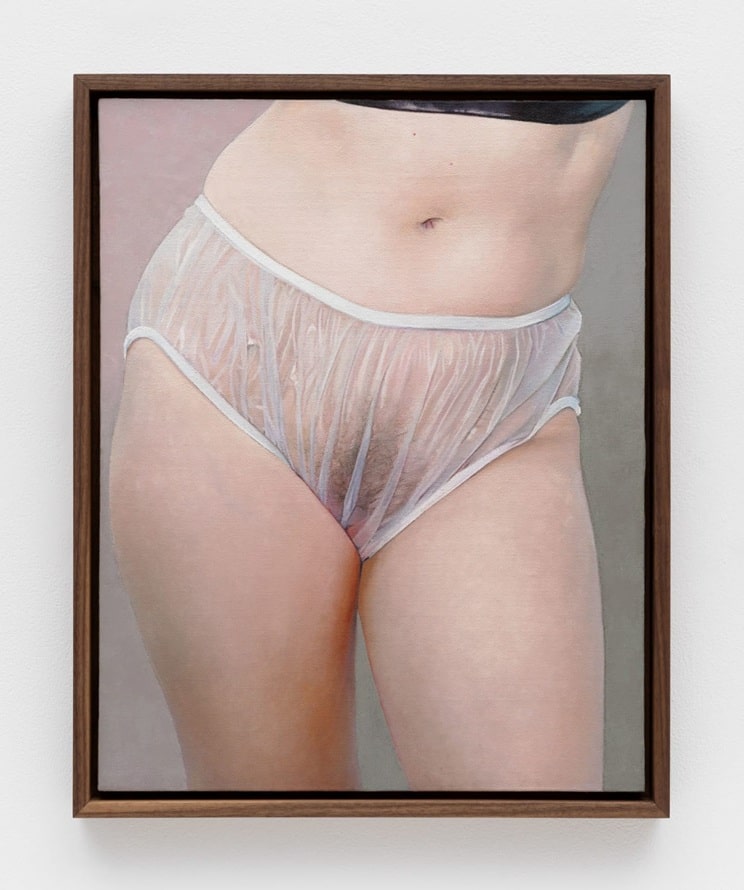
- Sikkema Malloy Jenkins (New York) presents a cross-section of gallery artists including Louis Fratino, Jeffrey Gibson, Sheila Hicks, Teresa Lanceta, Jennifer Packer, Kara Walker, and Luiz Zerbini. Spanning painting, textiles, ceramics, collage, and video, the presentation foregrounds diverse cultural perspectives that challenge and expand dominant narratives.
Embracing a spirit of collaboration, a record 20 exhibitors will present 10 joint booths at Art Basel Paris 2025 – nine in the main sector and one in Premise. Highlights include:
- Chapter NY (New York) and Soft Opening (London) – both first time participants at Art Basel Paris – join forces for a group presentation, featuring Olivia Erlanger, represented by Soft Opening, Stuart Middleton, represented by Chapter NY, and Gina Fischli, represented by both galleries. Among the highlights, Fischli debuts a series of animal sculptures arranged along a custom-built runway. In dialogue, Erlanger introduces a constellation of stainless-steel arrows mapping the Paris night sky in 1880, while Middleton contributes dissected clocks and industrial drawings.
- Christian Andersen (Copenhagen) and Fanta-MLN (Milan) present works by Patricia L. Boyd, Jason Hirata, Benjamin Hirte, and Lorenza Longhi. Engaging with the infrastructures that shape our contemporary lives – both physical and immaterial – the artists create gaps and fractures, striving to grasp these conditions and hint at possible shifts within them.
- Nicoletti (London) and seventeen (London) graduate from the fair’s Emergence sector to Galeries with a shared presentation of new works by Josèfa Ntjam, Abbas Zahedi, Patrick Goddard, and Justin Fitzpatrick. Conceived as an interconnected exhibition, the project explores exchanges between human consciousness, ecological systems, and socio-political structures, with works that employ flux, contamination, and mutation to reflect on questions of class, identity, and environment.
- Michael Rosenfeld Gallery (New York) and Jeffrey Deitch (New York, Los Angeles) jointly present sculptures by Karon Davis with paintings by Bob Thompson, who spent formative years as an artist in 1960s Paris. A cornerstone of the display is Black Monster (1959), a large-scale masterpiece exemplifying Thompson’s bold palette and figurative expressionism, complemented by additional works from 1959 to 1963. Davis’ sculptures enter into dialogue with Thompson’s canvases, offering resonant reflections on history, memory, and representation.
Further joint booth projects include Meyer Riegger (Berlin, Karlsruhe, Seoul, Basel) and Galleria Franco Noero (Turin), Misako & Rosen (Tokyo) and LambdaLambdaLambda (Prishtina), Felix Gaudlitz (Vienna) and LC Queisser (Tbilisi), Voloshyn Gallery (Kyiv, Miami) and Galerie Poggi (Paris), as well as Madragoa (Lisbon) and Galeria Dawid Radziszewski (Warsaw, Vienna).
This year’s edition also features a series of focused solo booth projects, offering immersive encounters with the practice of a single artist. Highlights include:
- Commonwealth and Council (Los Angeles) dedicates its booth to a solo presentation by Gala Porras-Kim. Through drawings and installations, the artist questions how objects are collected, classified, and displayed, raising issues of taxonomy, interpretation, and ethics. Presented in Paris, the project resonates with the city’s world-class museums and their role in shaping cultural narratives, as well as current discourses around restitution policies, while underscoring Porras-Kim’s position as a leading voice in the contemporary avant-garde.
- Carlos/Ishikawa (London) presents a solo booth of new works by Evelyn Taocheng Wang. Trained initially in classical Chinese painting, Wang draws on diverse art histories and literary references to explore questions of authenticity, identity, and belonging. By weaving personal narrative with East–West dialogues and autobiographical fragments, Wang challenges conventions of identity while reflecting on how the self is performed in everyday life.
- Galerie Cécile Fakhoury (Abidjan, Dakar, Paris) spotlights Binta Diaw with a new installation and photographs from her Paysage Corporel (Body Landscape) series. Rooted in her diasporic identity and informed by intersectional and ecofeminist thought, Diaw’s practice interlaces materiality, context, and sensory experience to question dominant historical narratives. Using natural elements such as earth, plants, water, and hair, she creates poetic yet politically charged works that reframe collective memory.
- Emalin (London) highlights a project by American artist and musician Jasper Marsalis, conceived especially for the fair. Combining audience-responsive video, motion-sensor technology, sculpture and painting, Marsalis explores the politics of performance, visibility, and the dynamics of spectatorship in today’s attention economy.
- The Modern Institute (Glasgow) will stage the first solo presentation in continental Europe of Korean painter Kim Bohie. Spanning new and historical works, the booth highlights Kim’s luminous landscapes shaped by the island of Jeju, where she has lived and worked since the early 2000s. Rooted in the traditions of sansuhwa (Korean landscape painting) yet informed by international influences, her panoramic compositions balance the real and the imagined, offering contemplative encounters with nature.
Emergence
Unfolding across the balconies of the Grand Palais’ Nave, Emergence features 16 solo presentations by some of today’s most promising artists. With eight galleries joining Art Basel Paris for the first time, the sector reflects the city’s enduring role as a place where new voices are discovered and avant-garde ideas continue to take shape, complementing the broader program of the fair. This year’s highlights include:
- Gauli Zitter (Brussels) will present dissociation variations, a solo project by Paris-based artist Ethan Assouline. Conceived as a whole exhibition within the booth, the project continues from Assouline’s recent solo show in Brussels. His sculptural compositions of found objects, sometimes painted or accompanied by his own poems, will revolve around the motif of the clock – a device that structures urban life while hinting at the political narratives embedded in the city’s landscape.
- Bank (Shanghai, New York) presents an immersive installation by Duyi Han. Comprising a series of ‘neuroaesthetic prescriptions,’ the work aims to transform rooms and objects into manifestations of mental states, interweaving folkloric and religious references with contemporary mental health practices.
- Blindspot Gallery (Hong Kong) will make its debut at Art Basel Paris 2025 with a solo exhibition of new papercut works by Xiyadie, a self-taught artist who transforms traditional Chinese folk craft into a radical medium of queer expression. His intricate scenes depict male lovers amidst rustic landscapes of farms and gardens, framed by peonies, animals, and celestial symbols.
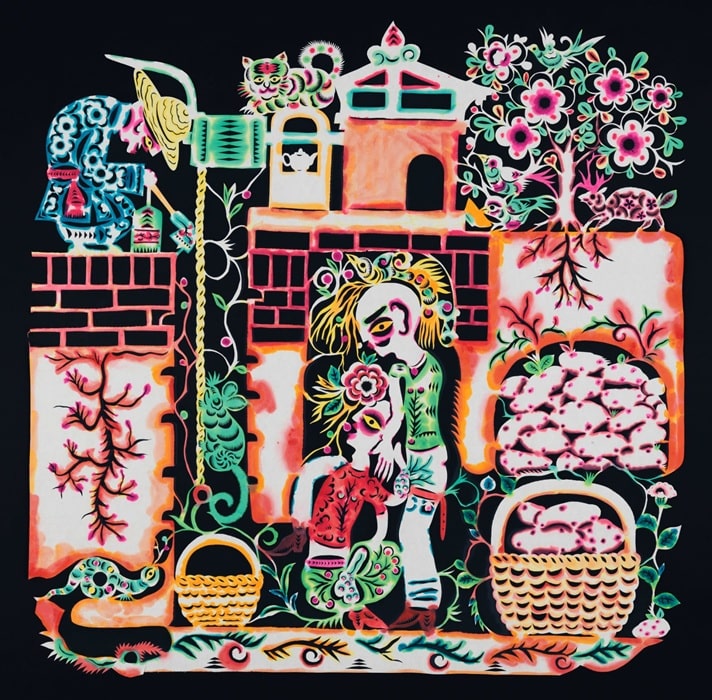
- Cibrián (San Sebastián), one of the sector’s first-time exhibitors, presents New Energy, a film installation combined with concept drawings with customized frames by Siyi Li. Centered on two women whose shifting roles and relationships unfold as they drive through Shanghai, the work explores creativity as a fluid and ever-changing force while drawing on the visual language of fashion editorials.
- Exo Exo (Paris) stages Bébé Boum, an installation by Paris-born artist Ash Love. Balloons printed with images from personal archives and collective iconography float alongside paintings resembling greeting cards, where the repeated ‘Happy Birthday’ underscores the erosion of meaning in standardized rituals. Through this imagery of celebration, Love addresses which narratives are commemorated and which are erased, pointing to the marginalization of queer histories.
- Heidi (Berlin) highlights the work of Kandis Williams, whose transdisciplinary practice spans collage, performance, writing, publishing, and pedagogy. Through meticulously layered collages and script-like performances, Williams critically dismantles narratives around race, nationalism, and power.
- Galerie Molitor (Berlin) debuts at Art Basel Paris with a solo project by Dora Budor. Vintages (2025) are video sculptures, built from repurposed champagne boxes and fresnel lenses, which project excerpts from Marcel L’Herbier’s 1928 film L’Argent, a Paris-based critique of financial speculation. The works reflect on cycles of distortion in history and spectatorship. Alongside, Reproduce Me (2025) repositions vintage IKEA tables modeled on French neoclassicism, probing how cultural heritage becomes commodity in the cycles of enrichment.
- Petrine (Paris, Düsseldorf) presents a new body of work by Sophie Kovel, Collections and Estates. The project unfolds in two strands: photographs and sculptures documenting jewels, porcelain, and decorative objects that trace the entanglements of philanthropy, diplomacy, and class imagination; and the video Uncovering/Extracting (2025), pairing archival footage with poetry to connect luxury display to histories of labor and extraction. Taking France and the United States as case studies, Kovel reflects on how histories of revolution, collection, and consumption continue to shape the present.
- Sophie Tappeiner (Vienna) presents Stealth Technology, a new body of work by Jala Wahid. The installation comprises four sculptures that intertwine the violence of military invasion and forced migration with intimate histories of love and resilience, rooted in the Wahid’s deep interest in the Kurdish diaspora.
- The Pill (Istanbul, Paris) presents a solo project by Nefeli Papadimouli, who lives and works between Paris and Athens. Her modular and elastic structures invite collective movement and create temporary architectures of assembly, exploring how bodies negotiate space and identity.
- Vardaxoglou Gallery (London) makes its debut at Art Basel Paris with a solo presentation by Tanoa Sasraku. The booth features Mascot (2025), a nearly five-metre-high sculpture made from newsprint, ink, and foraged mineral pigments from Ghana and Cornwall. Part of Sasraku’s Terratypes series, the work combines processes of collage, printmaking, and textile construction to weave together personal and historical narratives.
Further galleries participating in the sector are Drei (Cologne), presenting Mira Mann; Lars Friedrich (Berlin), presenting Sydney Schrader; Ginny on Frederick (London), presenting Arash Nassiri; ROH (Jakarta), presenting Kanitha Tith; Sweetwater (Berlin), presenting Alexandre Khondji.
Premise
Dedicated to curated, thematic presentations that may include work predating 1900, the second iteration of the Premise sector will feature nine booths and eight first-time participants. Together, these exhibitions highlight singular narratives that resonate with Paris’ legacy as a historic nexus of radicality.
- Kadel Willborn (Düsseldorf) presents a dialogue between Lucia Moholy (1894-1989), the Bauhaus photographer whose luminous abstractions shaped modern design, and Liz Deschenes (b. 1966), a leading voice in post-conceptual photography. Together, their works span a century of experimentation, showing photography as a medium that transcends documentation to become material, spatial, and immersive.
- Martine Aboucaya (Paris) stages a rare presentation of Robert Barry’s (b. 1936) immaterial works from 1969. Exploring telepathy, magnetism, and intangible phenomena, these conceptual landmarks shift perception from seeing to sensing, affirming Barry’s pioneering role in expanding the very definition of art.
- Pavec (Paris), returning to the sector, spotlights Marie Bracquemond (1840-1916), long overlooked in the history of Impressionism yet celebrated today as one of its great pioneers. Her still lifes, portraits, and landscapes from the 1870s-90s reveal a delicate, intimate gaze that transforms the everyday into visual poetry.
- The Gallery of Everything (London) makes a return with a revisit of the visionary paintings of Haitian artist and Vodou priest Hector Hyppolite (1894-1948). Celebrated by André Breton and featured in Le Surréalisme en 1947, Hyppolite’s vibrant works merge ritual, history, and spirituality, affirming his singular place in modern art.
- Frittelli arte contemporanea (Florence) highlights Dadamaino’s (1930-2004) radical ‘Volumi’ series (1959–1960), in which cut canvases activate the surrounding space as a living element of the work. Building on the legacies of Fontana and Manzoni, yet entirely her own, Dadamaino extended painting into a dialogue with light, volume, and void.
- Château Shatto (Los Angeles) pairs Emily Kame Kngwarreye (1910-1996), the Australian First Nations artist whose late-life paintings celebrate the intimate bond with her land, with Alan Lynch (1926-1994), whose works reflect a Zen-inflected harmony of color and form. Both artists transcend Western traditions to invent powerful, personal visual lexicons.
- Gordon Robichaux (New York) and Stars (Los Angeles) present Janet Olivia Henry (b.1947), whose dioramas and assemblages turn collecting into an act of freedom. Populated by dolls, shoes, and everyday objects, her miniature universes probe power, identity, and hidden hierarchies in art and society.
- Tina Kim Gallery (New York, Seoul) showcases South Korean artist Lee ShinJa (b. 1930), who in the 1950s and 1960s transformed textile traditions into a language of abstraction. Through embroidery, dyeing, and weaving, she elevated fabric from domestic craft to avant-garde experiment, weaving memory, nature, and poetry into form.
- Galerie Eric Mouchet (Paris, Brussels) revisits Ella Bergmann-Michel (1896-1971), a rare woman of the early Bauhaus and pioneering experimenter in photography, film, and collage. Her work across decades fuses abstraction, light, and movement, contributing a vital yet overlooked chapter to 20th-century modernism.
Public Program
Art Basel Paris’ Public Program unfolds across nine storied venues of the French capital. Miu Miu is Art Basel Paris’ Public Program Official Partner. From October 21 to 26, students from the École du Louvre will be present at all locations featuring artworks between 2pm and 5:30pm to provide visitors with information.
Palais d’Iéna
‘30 Blizzards.’, presented by Miu Miu, a project by Helen Marten
As part of the 2025 Public Program, Miu Miu presents 30 Blizzards. by British artist Helen Marten at the Palais d’Iéna. Known for her cross-disciplinary practice, Marten here stages her first major performance work, created in collaboration with theatre director Fabio Cherstich and composer Beatrice Dillon.
The project brings together five sculptures and five new videos, paired with monologues and libretto performed by a cast of thirty characters. Each performer is linked to a symbolic object and is choreographed through the space with song and speech, weaving themes of childhood, sexuality, community, interiority, and loss into a multi-voiced narrative. The title refers both to these thirty characters and to the idea of ‘blizzards’ as a metaphor for the turbulence of human temperament.
Installed within the formal architecture of the Palais d’Iéna, the work incorporates sculptural platforms, a central stage, and a circular track carrying vessels deployed in the performance. The result is a continuously unfolding environment in which sculpture, video, text, music and movement come together.
Miu Miu is the Public Program Official Partner of Art Basel Paris 2025. The project is realized in collaboration with the Palais d’Iéna, seat of France’s Economic, Social, and Environmental Council (CESE).
Place Vendôme
Alex Da Corte
At Place Vendôme, Alex Da Corte presents an inflatable sculpture based on the collapse of a Kermit balloon during New York’s 1991 Thanksgiving Day Parade. Half-deflated yet still afloat, the figure hovers in a state of suspended vulnerability. Its sagging body transforms an icon of childhood joy into a monument of fragility and delusion.
By isolating and monumentalizing this fleeting accident, Da Corte turns a symbol of optimism and childhood into an image of exhaustion and fragility. The piece continues his exploration of American pop culture as a site of both collective fantasy and buried unease – where cartoons, consumer icons and suburban ideals reveal their cracks.
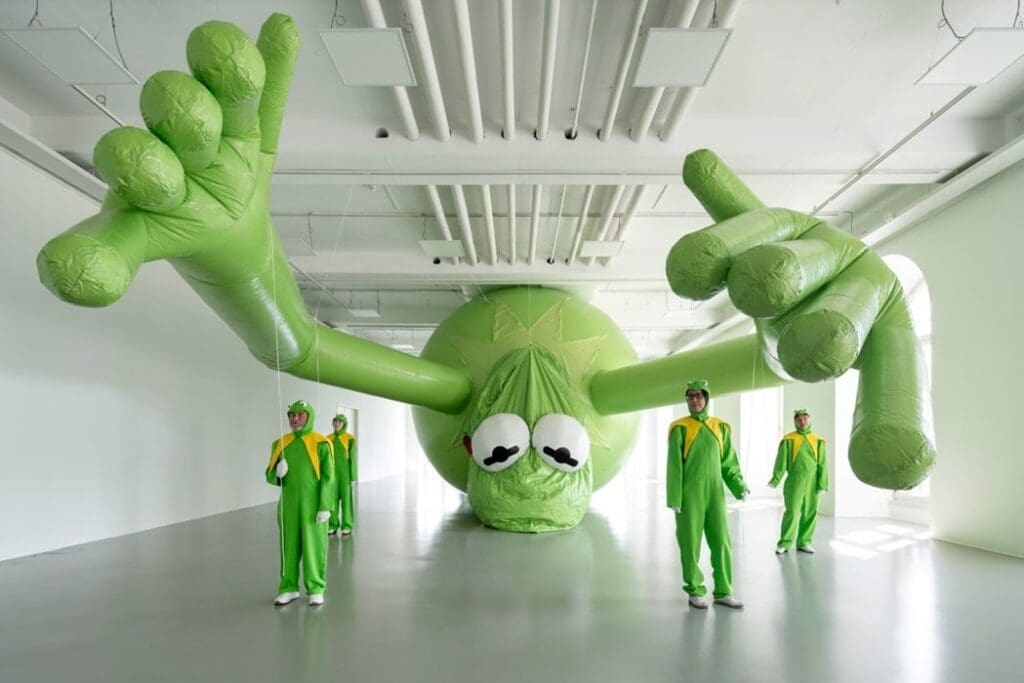
This is the fourth Public Program project realized by Art Basel Paris in collaboration with City of Paris on Place Vendôme. The work will be on view from October 20 to October 26, 2025. A performance activating the work will take place on Monday, October 20, 2025 at 4pm.
Cité de l’architecture et du patrimoine
Fabienne Verdier – ‘Mute’ & ‘Chromoscope’
Curated by Matthieu Poirier
At the Cité de l’architecture et du patrimoine, Fabienne Verdier presents ‘Mute’, an exhibition of 40 large-format abstract paintings. The title resonates in English with ‘silence’ and in French with the imperative muter – to mutate – underscoring the artist’s exploration of stillness, transformation, and flux. Emerging from a rigorous gestural practice, the works are installed in a labyrinthine scenography that engages with the museum’s volumes and its medieval collections.
Verdier (b. 1962, Paris) is known for her fusion of Western abstraction and techniques inspired by Chinese calligraphy, developed during a decade of study in China in the 1980s. Her practice combines ascetic gesture with natural forces, creating paintings that appear suspended between control and chance.
Also at the Cité, the exhibition ‘Chromoscope’ examines the Color Field and Post-Painterly Abstraction movements between 1955 and 1992. Installed in the Murals Gallery, among the medieval chapels and frescoes, it brings together 23 large-scale paintings from artist estates and private collections. Works by Thomas Downing, Sam Francis, Helen Frankenthaler, Adolph Gottlieb, Morris Louis, Robert Motherwell, Kenneth Noland, Jules Olitski, Larry Poons, and Frank Stella reveal the fluidity of pigment, the circulation of the gaze, and the vibratory transparency that define the movement.
Color Field painting emerged in the United States in the 1950s as a response to Abstract Expressionism, shifting from gestural brushwork to large, luminous expanses of color intended to overwhelm the viewer’s senses. By revisiting this legacy within the context of the Cité’s medieval chapels, Chromoscope underscores how abstraction reshaped the experience of painting in the modern era.
These are the first Public Program projects realized by Art Basel Paris in collaboration with Cité de l’Architecture et du Patrimoine. The exhibitions will be on view from October 22, 2025 to February 16, 2026.
Chapelle des Petits-Augustins des Beaux-Arts de Paris
Harry Nuriev
For Art Basel Paris 2025, Harry Nuriev presents Objets Trouvés (2025), a participatory installation transforming the Chapelle des Petits-Augustins into a space of circulation and exchange. Supermarket boxes, neatly arranged in rows, are filled with objects brought by visitors. Each person leaves behind something they no longer need and takes an item left by others. Every contribution is certified as an artwork, and at the end of the exhibition, all exchanges will be compiled into a Yellow Pages–style book, turning a fleeting process into a permanent archive.
Harry Nuriev describes his practice as Transformism – the reimagining of everyday materials to propose new functions and meanings. With Objets Trouvés, he extends this philosophy into a collective dimension, where the simple act of exchange becomes both social interaction and artistic creation.
This is the fourth Public Program project realized by Art Basel Paris in collaboration with Beaux-Arts de Paris. The project will be on view from October 21 to October 26, 2025.
Petit Palais
Julius von Bismarck
At the Petit Palais, Julius von Bismarck presents The Elephant in the Room (2023-2024) a pair of monumental kinetic sculptures that continually collapse and reassemble. A life-sized taxidermy giraffe stands beside a reduced replica of an equestrian statue of Otto von Bismarck. Both seem stable yet repeatedly fall apart, their segmented bodies controlled by hidden mechanisms.
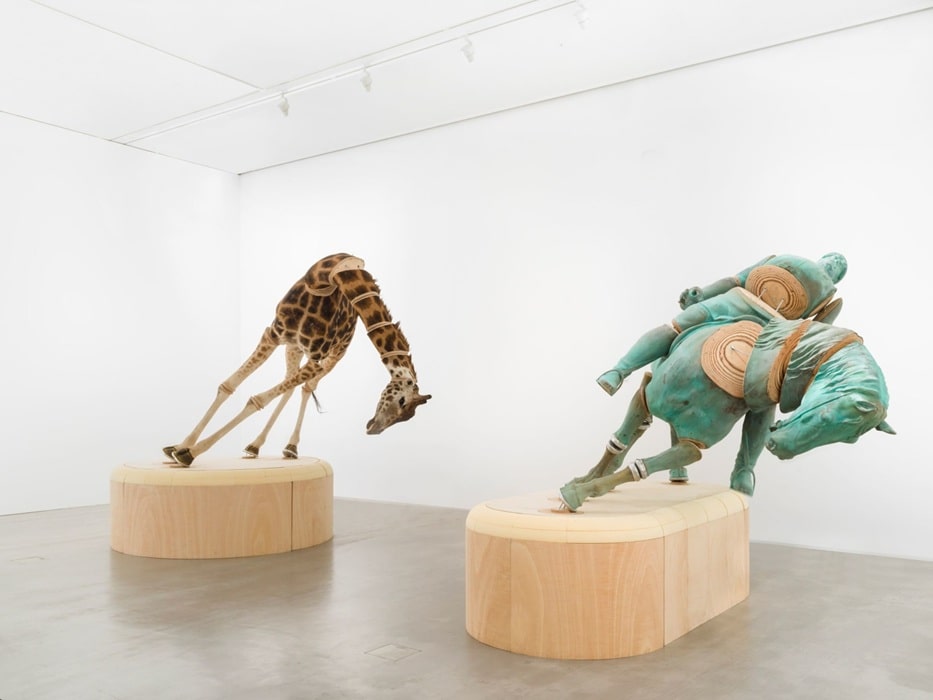
By pairing the exoticized animal with a monument to the German Empire’s first chancellor, von Bismarck highlights the intertwined histories of colonial exploitation and political power. Their endless cycle of collapse and recovery becomes an allegory for the fragility of monuments and the contested narratives they uphold.
In addition to the two sculptures, von Bismarck will also present a series of signature wood panel works from his series ‘OOOSB’ (2024-2025), as well as the video work Grenzen der Intelligenzen (Boundaries of Intelligences, 2024), both of which continue his exploration of how nature can be recontextualized, conservated, and manipulated.
This is the second Public Program project realized by Art Basel Paris in collaboration with Petit Palais and Paris-Musées. The project will be on view from October 21 to October 26, 2025.
Parvis de l’Institut de France
Ugo Rondinone
On the parvis of the Institut de France, Ugo Rondinone presents the innocent (2024), a monumental sculpture standing over four meters tall. Composed of stacked blocks of bluestone that suggest heads, torsos, and legs, the figure rises with archaic simplicity yet shifts with light and weather throughout the day.
Rondinone has long explored elemental forms as metaphors for the human condition. With the innocent, he brings this vocabulary to the historic heart of Paris. The work stands as both sentinel and witness – coarse yet fragile, timeless yet immediate – linking contemporary life to deep cultural memory and the endurance of the human form. Avoiding classical modeling, the work embraces a primal clarity, recalling ancient signposts or totems used to guide travelers through remote landscapes.
This is the third Public Program project realized by Art Basel Paris in collaboration with the City of Paris on the Parvis de l’Institut de France. The work will be on view from October 17 to October 28, 2025.
Musée national Eugène-Delacroix
Nate Lowman
At the Musée national Eugène-Delacroix, Nate Lowman stages ‘After Delacroix’ (2025), a project that reinterprets the Romantic painter’s legacy through a contemporary lens. The exhibition unfolds as a constellation of works – including new canvases, light sculptures, and small-format paintings – that filter Delacroix’s influence through echoes of Théodore Géricault and Cecily Brown.
At its center is Delacroix Palette (2025), a painting that treats the painter’s tool not just as an object but as a surface of accumulated gestures and residues. Around it, Lowman juxtaposes reinterpretations of Delacroix motifs with appropriations of Cecily Brown canvases that themselves draw on Delacroix and Géricault, creating a layered chain of references. Copying here becomes a form of invention, revealing how gestures and moods survive across centuries.
This is the fourth Public Program project realized by Art Basel Paris in collaboration with the musée national Eugène-Delacroix and the musée du Louvre at the venue. The project will be on view from October 22 to November 2, 2025.
Hôtel de la Marine
Joël Andrianomearisoa
At the Hôtel de la Marine, Joël Andrianomearisoa presents Les Herbes folles du vieux logis (2020-2025), a monumental textile work. Composed of two vast panels of richly colored and textured fabric, the piece envelops the viewer in an imagined landscape. Its title pays homage to Malagasy poet Maurice Ramarozaka, underscoring the artist’s ongoing dialogue with language, memory, and cultural roots.
The work draws on the traditions of tapestry and weaving while affirming the physicality of textile as a contemporary medium. For Andrianomearisoa, the act of making is ‘the power of the hand’ – a gesture that carries history, ritual, and emotion. The work presented in the courtyard of the Hôtel de la Marine translates this sensibility into a visual field where colour and texture echo the abundance of nature and the resilience of craft.
This is the second Public Program project realized by Art Basel Paris in collaboration with the Centre des Monuments Nationaux at the venue. The work will be on view from October 10 to November 2, 2025.
Avenue Winston-Churchill
Thomas Houseago, Leiko Ikemura, Wang Keping, Vojtěch Kovařík, Muller Van Severen, Arlene Shechet, Stefan Rinck
For the 2025 edition of Art Basel Paris, avenue Winston-Churchill will host a sequence of large-scale sculptures. Connecting the Petit Palais and the Grand Palais, the avenue will be pedestrianized for the duration of the fair, allowing visitors to encounter seven major projects conceived for the public realm. The works featured are:
- Thomas Houseago‘s Flower & Death (2018-2025) (presented by Lévy Gorvy Dayan and Xavier Hufkens), a bronze figure combining skeletal and floral forms, first exhibited at the Royal Botanic Gardens, Kew in 2021
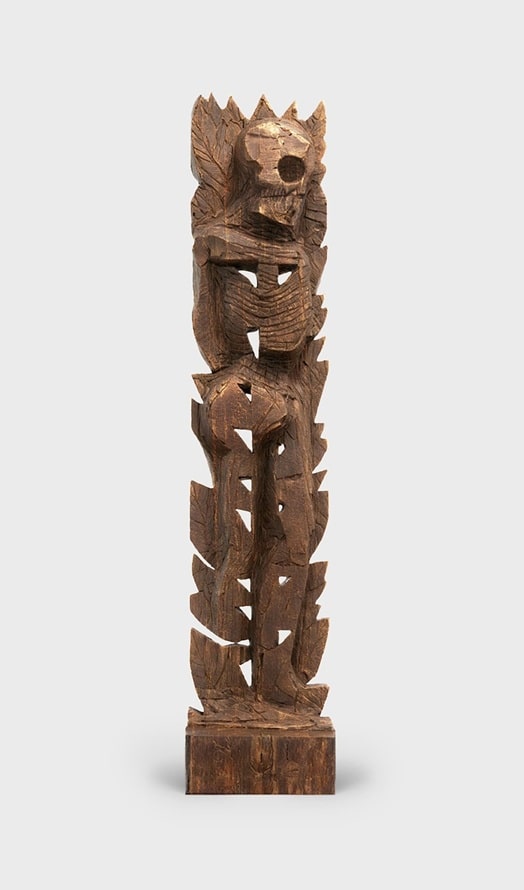
- Leiko Ikemura‘s Usagi Greeting (440) (2023-2025) (presented by Lisson Gallery), a patinated bronze sculpture of Ikemura’s hybrid rabbit-goddess figure, created in response to the 2011 Tōhoku earthquake and Fukushima disaster
- Wang Keping‘s Découverte (2022) (presented by Galerie Nathalie Obadia), a 2.5-metre bronze celebrating the female form through abstraction and reduction
- Vojtěch Kovařík‘s Atlas calming the troubled world (2025) (presented by Galerie Derouillon), a new bronze depicting the Greek divinity Atlas gently embracing the Earth, realized in Kovařík’s signature rounded style
- Muller Van Severen‘s Concrete Wire (2025) (presented by Tim Van Laere Gallery), three concrete sculptures cut and folded from single plates, referencing Suprematist geometry while inviting physical interaction, with which visitors are invited to interact
- Arlene Shechet‘s Dawn (2024) (presented by Pace Gallery), a painted aluminum sculpture in pastel tones, part of Shechet’s ‘Girl Group’ series, first shown at Storm King Art Center in 2024
- Stefan Rinck‘s Camarillo in Disguise (2025) (presented by Semiose), a three-meter limestone figure that merges historical, mythological, and pop-cultural influences, carved using traditional stonemasonry techniques
This is the second Public Program project realized by Art Basel Paris in collaboration with City of Paris on avenue Winston-Churchill. The works will be on view from October 21 to October 26, 2025.
Conversations
Held at the Petit Palais, Art Basel’s flagship talks program situates today’s boundary-breakers within Paris’s avant-garde tradition. The 2025 edition brings together artists Marta Minujín, Tyler Mitchell, Cai Guo-Qiang, Josèfa Ntjam, and Kiddy Smile; institution leaders Chiara Parisi and Chris Dercon; architect Frida Escobedo; gallerist Emmanuel Perrotin; and many others.
This year also marks the debut of a new concept for Art Basel’s Conversations: a day-long strand curated by celebrated British fashion editor Edward Enninful, marking the launch of his new media and entertainment company EE72. Conceived as a prelude to his forthcoming exhibition ‘The 90s’ at Tate Britain (2026), Enninful’s program – held on Friday, October 24 – presents one-to-one conversations with four revered artists who rose to the fore in the 1990s alongside Enninful: Yinka Shonibare CBE, Juergen Teller, Sonia Boyce, and Mark Leckey.
Further highlights from the Conversations Program include:
- Argentinian artist Marta Minujín revisits her radical Paris happenings of the 1960s with architect Frida Escobedo, who shares her vision for the Centre Pompidou’s 2030 renewal, in a discussion moderated by Hans Ulrich Obrist.
- American photographer Tyler Mitchell, whose first French institutional solo show opens at the Maison Européenne de la Photographie, explores photography’s evolving role in shaping cultural memory.
- Emmanuel Perrotin, Chiara Parisi, and Mina Soltangheis consider how France’s art ecosystem balances local identity with international reach, in conversation with Martin Bethenod.
- Fondation Cartier’s General Director Chris Dercon joins artist Cai Guo-Qiang, whose singular use of gunpowder has profoundly expanded the language of contemporary art, to look back at the artist’s enduring relationship with the Fondation ahead of its grand reopening, moderated by Art Basel’s Executive Editor Coline Milliard.
- Artist William Mapan and Centre Pompidou curator Philippe Bettinelli, moderated by Art Basel Head of Editorial Dr Jeni Fulton, examine how Paris fosters digital practices, from pioneering media collections to today’s AI debates.
- Artists Kiddy Smile and Josèfa Ntjam explore storytelling as resistance across ballroom culture, film, and speculative myth.
Oh La La!
This year’s edition of Oh La La! – Art Basel Paris’ special initiative inviting galleries to present new works at their booths on Friday and Saturday of the fair – will be art-directed by fashion expert and journalist Loïc Prigent. The theme of this year’s edition is ‘À la mode’.
Fashion and art have always been deeply entwined, shaping and mirroring each other over time. Likewise, the concept of ‘trends’ has long sparked debate among critics and creators, leaving a lasting imprint on both fields. With ‘À la mode,’ visitors are invited to explore these intersections, tracing a conceptual thread across the Art Basel Paris 2025 show floor.
Exhibitors are encouraged to present works that engage with these ideas, whether overtly or through subtle references. Style, the political and social meaning of garments, elegance, timelessness, dress as an expression of culture or identity, textile design, the role of avant-gardes in both art and fashion, and the elusive quality of chic are all potential areas of inspiration. The list of participating artists and galleries will be revealed shortly before the beginning of the fair. As part of Art Basel’s partnership with Airbnb, visitors will be able to book an exclusive tour of the Oh La La! parcours led by Loïc Prigent on October 24 and 25.
About Loïc Prigent
Loïc Prigent is a French filmmaker specializing in fashion documentaries. Born in Brittany in 1973, he began as a journalist at Libération before moving to television in 1995, where he covered Fashion Weeks. His breakthrough came with Signé Chanel (2006), an unprecedented look inside the Chanel ateliers with Karl Lagerfeld, which established him as a leading voice in fashion storytelling. He has since directed acclaimed films including Marc Jacobs & Louis Vuitton (2007), Karl Lagerfeld dessine sa vie (2014), Jean Paul Gaultier au travail (2015), and L’héritage d’Alexander McQueen (2015), as well as the series Le jour d’Avant.
Prigent is also the author of several books, including J’adore la mode mais c’est tout ce que je déteste and Mille milliards de rubans, une histoire de la mode. He runs the platform fashionmoodboard.com and continues to bring fashion to wider audiences through his TV program 5 minutes de mode. Since 2019, he has expanded his presence on YouTube, covering Paris and Milan fashion shows and producing videos on the history of fashion alongside his ongoing work for television.
WHEN?
Vernissage: Thursday, October 23, 2pm to 8pm
Days:
Friday, October 24, 11am to 7pm
Saturday, October 25, 11am to 7pm
Sunday, October 26, 11am to 7pm
WHERE?
Grand Palais
Avenue Winston Churchill
75008, Paris
COSTS?
Regular Day Ticket: 45 EUR
Reduced Day Ticket: 30 EUR
Permanent Ticket: 120 EUR
Permanent+ Ticket: 200 EUR


